Get Both Sides of the Story This Clean Night
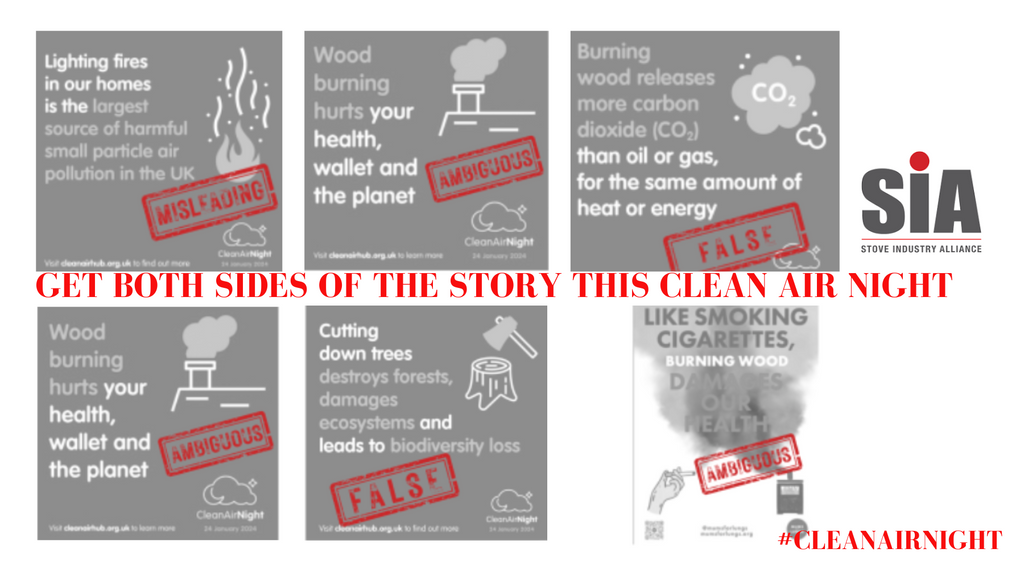
Clean Air Night 2024 (Wednesday 24th January) is being focused on what campaigners are calling the “uncomfortable truth about wood burning” and follows a prolonged period this winter where consumers have been targeted by an intense and very well-funded series of anti-burning messages by the likes of Mums for Lungs, London Wood Burning Project and Global Action Plan / Clean Air Hub.
Much of the messaging used by these groups relies on a very negative and, at times, sensationalist narrative that seeks to condemn all forms of domestic burning rather than educate users of sustainable solid fuel stoves on how best to choose and use their appliances in order to minimise emissions. A range of misleading and, in some cases, false, claims are being made which are designed to scare, not educate.
The uncomfortable truth is that these campaigns rely on flawed data and sweeping generalisations. So, this Clean Air Night we urge consumers to get both side of the story as we look at some of the anti-burning adverts you may have seen recently, shedding light on why they are misleading, ambiguous and, in some cases, untrue.
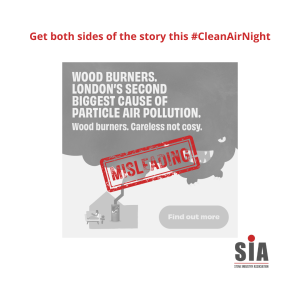
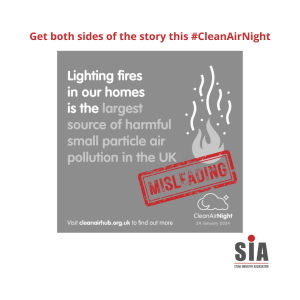
The claims made here by the London Wood Burning Project (above left) and cleanairhub.org.uk (above right) rely on the grouping of all methods of burning wood (including garden bonfires & firepits) at home. However, the data from the National Atmospheric Emissions Inventory (NAEI) shows us that burning dry wood on an Ecodesign compliant stove accounted for less than 0.1% of total UK PM2.5 emissions in 2021.
Modern stoves offer a range of benefits and you can get both sides of the story and learn more about that here.
Just like the posts above, the term ‘wood burning’ in this post (below) is deliberately ambiguous and takes no account of the type of appliance or quality of the wood fuel.

There is reliable evidence that using dry wood and other sustainable solid fuels can help consumers reduce their home heating bills. A recent study by Gemserve for Homefire found that households with gas central heating that adopt zonal heating using dry wood fuel could save up to 7% on their annual heating bill and up to 11% using smokeless solid fuel in the same way.
The same study also found that using renewable, sustainably sourced wood fuel instead of fossil fuel gas results in typical carbon savings of over half a tonne of CO2e / year.
You can read more about this study here

The claim (above) that a wood burning stove is six times more polluting than an HGV is hugely misleading.
The claim is based on a report by the European Environmental Bureau published in 2022 that looks at the amount of emissions given off by generating a GJ of heat in a stove compared to the emissions releases generating a GJ of power in an HGV.
The claims made by the study rely on a simplistic calculation using permitted rates of emission. The study also fails to factor in the non-exhaust emissions of the HGV.
What we end up with is an apples and oranges comparison that fails to consider the impact of real-world use. According to a 2020 Defra report, on average stove users light their stoves for between 3.7 and 4.5 hours a day during the winter months. An HGV can be driven by the same driver for up to 9 hours per day, and the vehicle potentially operates 24/7 up to 365 days a year.
This means that over the course of 1 week’s real-world use a Euro 6 HGV actually produces 13 times more PM2.5 (271g) than an Ecodesign stove (20.16g). You can read more on this comparison here.
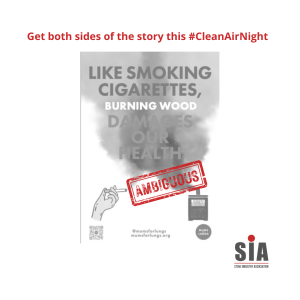
This claim (above) by campaign group Mums for Lungs is ambiguous and relies on the reader not seeking any further information on the data.
The data from the National Atmospheric Emissions Inventory (NAEI) which breaks down UK PM2.5 emissions by activity and source, shows us that in 2021 cigarette smoking accounted for 12 times more PM2.5 in the UK than burning dry wood on an Ecodesign compliant stove did.
Some of the adverts by the cleanairhub.org.uk, part of Global Action Plan, in support of Clean Air Night even contain false claims (see below).
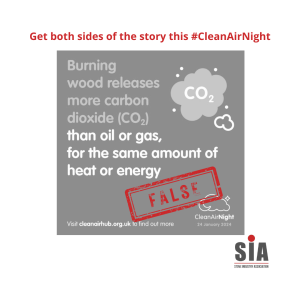
This is one example. Contrary to the information given in this post, wood logs have the lowest carbon emission factor of any domestic heating fuel at 0.01kg CO2e per kWh. That’s 1/20th the carbon emissions of natural gas or electricity, and 1/29th that of oil.
Burning dry wood is a modern, Ecodesign compliant stove is a low carbon way to heat you home and can play a key role in helping the UK to meet its net zero objectives.
You can find out more about the benefits of choosing modern stoves here.
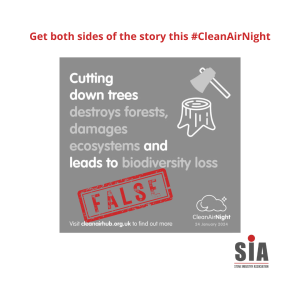
This statement (above) is false. Woodland management is needed to ensure healthy forests and the ecosystems they support.
Wood fuel is a key component of the woodland management cycle and the economies attached to it. Using wood as fuel also plays a vital role in maintaining woodland diversity, health, and resilience. Locally sourced wood fuel helps support small businesses and reduces the carbon footprint of fuel transport.
You can learn more about the importance of woodland management here
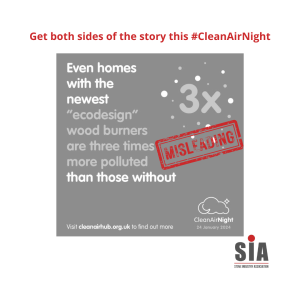
This is another misleading statement (above) and one which is actually disproved by the findings of a recent Imperial College study which found that a “clearSkies Level 5 stove demonstrated some benefits for indoor air quality” and that “the biggest increases in PM2.5 concentrations indoors did not relate to indoor wood or solid-fuel burning but instead were a result of cooking…”.
A literature review by commissioned by the SIA and carried out by the University of Manchester found no scientific evidence for adverse health impacts from exposure to the indoor air typically associated with modern, enclosed wood burning stoves.
You can read more about this here
And lastly for something positive. We could not agree more with this post and there are significant reductions (up to 90%) possible in the emissions created by domestic burning by switching from open fires and older stoves to modern, Ecodesign compliant stoves.

The SIA encourages all solid fuel stove users to educate themselves on the importance of:
- Using the right appliance – if you use an open fire or an older stove it is time to upgrade. A modern Ecodesign compliant stove releases up to 90% less emissions than an open fire and up to 80% less than many older stoves.
- Ensuring your stove is fitted by an appropriately qualified competent person e.g. HETAS or OFTEC registered.
- Always use good quality fuel. Look for the Ready to Burn logo and never use chemically treated wood or burn waste on your stove.
- Get your stove serviced and your chimney swept at least once a year. We recommend NVQ qualified sweeps for this.


Comments on this post (0)